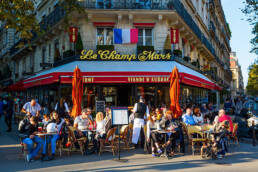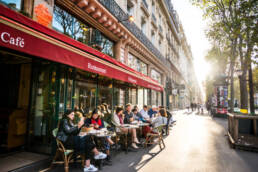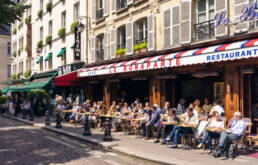During my recent week-long stay in Paris, I deliberately embraced the idea of having no fixed plans. Too often, vacations become a checklist of sights to see, and we overlook the essence of why we chose a destination. In an unfamiliar city, I prefer exploring on foot, allowing for serendipitous discoveries that a cab or train might miss.
Towards the end of my stay, I couldn’t help but notice the stark contrast in sidewalk culture between Paris and my hometown, New York. Despite similar climates, Parisians demonstrated a greater willingness to gather outdoors, even in what Americans might consider less-than-ideal temperatures.
As I write this in a cozy coffee shop with a large retractable garage doors in front of me, I’m reminded of my Parisian experience where this door would be opened up, inviting patrons to spill out onto the sidewalk even on this mild 55-degree January day.
The vibrant street life of Paris stood in sharp contrast to the sleepy sidewalk culture I had just come from as New Yorkers started to hunker down for winter. This contrast intrigued me, prompting an investigation into why I felt like this and what the major incentives were to engage the sidewalk in this way.
Business Incentives for Sidewalk Utilization
From a business perspective, utilizing sidewalk space offers immense benefits. Increased visibility draws attention from passersby, potentially attracting new customers. Basic design considerations, such as outdoor seating and a physical connection to the exterior, not only expand seating capacity and flexibility but also provide varying dining experiences based on weather or personal preferences.
Community and Cultural Impact
Beyond business benefits, there are positive effects on the neighborhood and cultural experience. A vibrant sidewalk culture transforms simple comings and goings in the street into theater. A small yet important detail that stood out to me was that many of the outdoor café chairs, rather than oriented across the table being face to face with your friend, were pointed outward to look directly at the pedestrians and street beyond. This furniture placement became an informal, never-ending amphitheater for the sport of people-watching as you sat and enjoyed a coffee or aperitivo.
Safety
Outdoor spaces contribute to a vibrant street life, attracting visitors and enhancing the sense of public safety. High visibility and physical connection to the exterior substantially affect the sense of public safety when viewed from the street. Jane Jacobs emphasized the importance of a critical mass of people in urban centers as a deterrent to crime.
Applying Lessons to Home City
Reflecting on my Parisian experience, I see potential for improving my home city’s neighborhoods through similar sidewalk practices. While outdoor dining structures emerged during the COVID-19 pandemic, there’s room for improvement. Most businesses only had the time and resources to slap up ramshackle, plywood sheds that now, after several winters, are either deteriorating or forced to have been removed by the city.
Despite some businesses embracing outdoor areas, more decision-makers need to recognize the benefits of creating safer, more versatile, and inviting neighborhoods through thoughtful sidewalk design.








